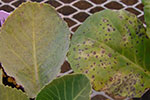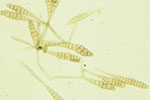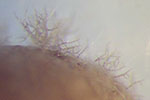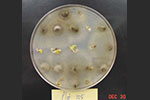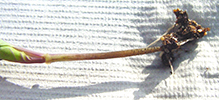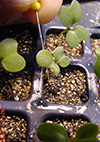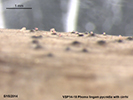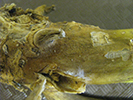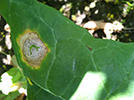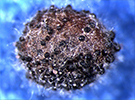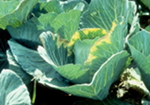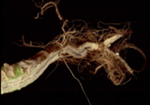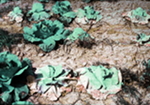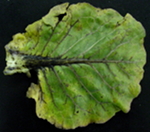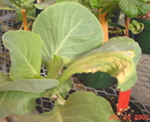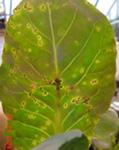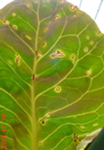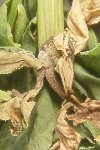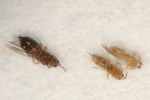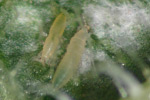Photo Gallery of Vegetable Problems
Cabbage
(Click on photo to enlarge)
General Cabbage Disease and Pest Management
Cabbage Diseases: Ecology and Control, by Anthony P. Keinath, Marc A. Cubeta, and David B. Langston, Jr.
Cabbage/Kale, Brassicas. infonet-biovision. Photos of various disease and pest problems on brassica crops.
Crop Profile for Cabbage Seed in Washington, by Lindsey J. du Toit, Washington State University Mount Vernon NWREC.
Crucifer Disease Guide - A Practical Guide for Seedsmen, Growers and Agricultural Advisors. Published by Seminis Vegetable Seeds, Inc.’s Plant Health Department and Seed Health Departments.
Small-Scale Cost-Effective Hot Water Seed Treatment
Reduce the risk of seed-borne diseases, especially for organic Brassica
growers.
Diseases
Disease: Alternaria black spot
Pathogens: Alternaria brassicae and Alternaria brassicicola
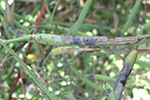 |
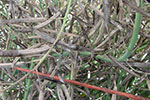 |
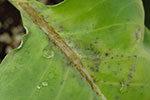 |
| Alternaria black spot on pods in a cabbage seed crop. | Severe Alternaria black spot on pods in a cabbage seed crop. | Alternaria black spot symptoms on a cabbage leaf. |
| Photo Source: Lindsey du Toit | ||
On-Line Resources:
Alternaria Diseases of Crucifers. Plant Pathology Fact Sheet PP–34, Florida Cooperative Extension Service/Institute of Food and Agricultural Science/University of Florida.
UC Pest Management Guidelines: Cole Crops: Alternaria Leafspot. UC IPM Online, University of California.
Crucifer Diseases: Alternaria Leaf Spot. AVRDC International Cooperators’ Fact Sheet.
Disease Management: Alternaria Diseases of Brassicas. The Plant Diagnostic Clinic, UMassAmherst.
Disease: Black Leg
Pathogens:Phoma lingam (sexual stage = Leptosphaeria maculans)
Host crops:Most members of the Brassicaceae (Cruciferae) = cabbage family, including broccoli, Brussels sprouts, cabbage, canola, cauliflower, various Chinese brassica vegetables, collard, kale, mizuna, mustard, oilseed rape, oilseed turnip rape, rutabaga, turnip, etc.), Sinapis (white and yellow mustard), and Raphanus (daikon and radish). Several wild species exist that may be infected by P. lingam including Descurainia (tansymustard), Sisymbrium (hedge mustard), and Thlaspi
(penny-cress). This is a quarantine disease in six counties in
northwestern WA and all counties east of the Cascade Mountains because of
the risk of this pathogen to the brassica vegetable seed industry.
On-Line Resources:
Video: Blackleg Disease and Resistance Management. Published by the Canola Council of Canada.
Pacific Northwest Plant Disease Management Handbook: Seed Crop, Crucifers-Blackleg
Black leg in Brassicaceae crops and wild crucifers: 2014 outbreak in the Willamette Valley of Oregon
Black Leg, Light Leaf Spot, and White Leaf Spot, Cynthia Ocamb, PhD., Plant Pathologist, OSU Extension, Associate Professor--Botany & Plant Pathology.
Fungicides for Control of Black Leg, David Priebe, Pesticides Program, Oregon Department of Agriculture.
Addressing Blackleg in the Willamette Valley: Oregon Department of Agriculture permanent ruling released on black leg of brassicaceae in January 2015 – see the Brassica Production Districts document, and the OSDA Permanent Ruling document titled ‘Crucifer blackleg disease requirements moved into one regulation; removes same requirements from rapeseed production districts,’ below.
- Oregon Secretary of State Certificate and Order for Filing - PERMANENT ADMINISTRATIVE RULES: Crucifer blackleg disease requirements moved into one regulation; removes same requirements from rapeseed production districts.
- Brassicaceae Production Districts and Rapeseed Control Areas (603-052-0860), Oregon Department of Agriculture.
Management of Black Leg in Oregon on Brassica seed crops, a Clinic Close-up, Oregon State University Extension Service.
Management of Black Leg in Oregon on Vegetable Brassica Crops and Seed Crops, a Clinic Close-up, Oregon State University Extension Service.
Disease: Black rot
Pathogens: Xanthomonas campestris pv. campestris
Host crops: Most members of the Brassicaceae (Cruciferae) = cabbage family, including
broccoli, Brussels sprouts,
cabbage, canola,
cauliflower, various Chinese brassica vegetables, collard, kale, mizuna,
mustard, oilseed rape, oilseed turnip rape, rutabaga, turnip, etc.), Sinapis (white and yellow mustard), and Raphanus (daikon and
radish). Most
wild species can be infected by this pathogen. This is a quarantine disease in parts of six counties in northwestern Washington because of the risk of this pathogen to the brassica vegetable seed industry.
Online Resources:
Cabbage and Cauliflower (Brassica sp.)-Black Rot, Pacific Northwest
Handbooks, a Pacific Northwest Extension Publication.
Black Rot of Crucifers, Fact Sheet, Cooperative Extension, New York State,
Cornell University.
Field Scouting Guide: Black Rot of Brassicas, Growing Produce, Meister Media
Worldwide’s Horticulture Group.
Managing Black Rot of Cabbage and other Crucifer Crops in Organic Farming
Systems, eOrganic, eXtension Foundation (extension.org).
Brassicas, Black Rot, UMass Extension vegetable Program Fact Sheet, Center
for Agriculture, Food and the Environment, College of Natural Sciences,
University of Massachusetts, Amherst, MA.
Disease: Botrytis stem blight
Pathogen: Botrytis cinerea
On-Line Resources:
Disease: Clubroot
Pathogen: Plasmodiophora brassicae
Host crops: Broccoli, cabbage, cauliflower, brassicaceae (cruciferous) weeds, and radish.
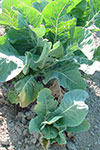 |
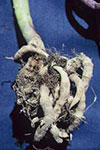 |
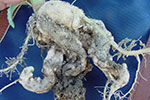 |
| Stunting from clubroot. | Below-ground symptoms of clubroot. | |
| Photo Source: Lindsey du Toit | ||
On-Line Resources:
Pacific Northwest Plant Disease Management Handbook: Cabbage and Cauliflower (Brassica) – Clubroot
Clubroot of Crucifers. Vegetable MD Online.
Clubroot. Wikipedia.
Clubroot of vegetable brassicas – towards integrated control. New Zealand Institute for Crop & Food Research Ltd.
Clubroot of Crucifers. The Ohio State University Extension.
Managing Clubroot: Equipment Sanitation Guide. Canola Council of Canada
Top 10 tips from the 2013 International Clubroot Workshop. Canola Watch, Canola Council of Canada.
See Diseases, pests, and other problems common to many vegetables: Clubroot of brassica vegetables.
Disease: Downy mildew
Pathogens: Hyaloperonospora parasitica = Peronospora parasitica
Host crops: Most members of the Brassicaceae (Cruciferae) = cabbage family, including cabbage and cauliflower.
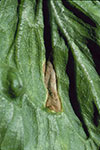 |
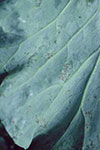 |
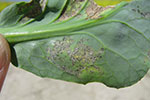 |
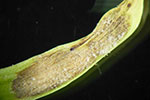 |
| Downy mildew sporulation on cabbage leaves. | Sporulation of downy mildew on a cabbage seed pod in a cabbage seed crop. | ||
| Photo Source: Lindsey du Toit | |||
On-Line Resources:
Downy Mildew of Crucifers. Plant Pathology Fact Sheet. Florida Cooperative Extension Service.
Brassica Downy Mildew. University of Massachusetts Amherst.
See Brassicaceae: Downy Mildew.
Disease: Ring spot
Pathogen: Mycosphaerella brassicicola
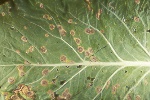 |
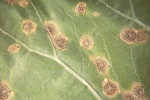 |
Photo Source: D.A. Inglis |
|
Insect/Mite Pests
Common name: Diamondback moth
Latin binomial: Plutella xylostella
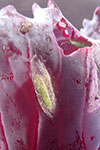 |
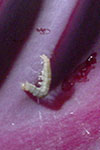 |
| Diamondback moth pupa with imported cabbageworm hole damage to leaves. | Diamondback moth larva on cabbage. |
| Photo Source: Photographer – Johnny Stark. Submitted by Jenny Glass | |
On-Line Resources:
Caterpillar Pests of the Cabbage Family. Washington State University Fact Sheet FS018E.
Pacific Northwest Insect Management Handbook. Chapter: Vegetables, Section: Boccoli, Cabbage, other Crucifers.
Common name: Imported cabbage worm
Latin binomial: Pieris rapae
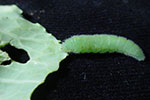 |
| Imported cabbage worm by damaged cabbage leaf. |
| Photo Source: Photographer – Johnny Stark Submitted by Jenny Glass |
On-Line Resources:
Caterpillar Pests of the Cabbage Family. Washington State University Fact Sheet FS018E.
Pacific Northwest Insect Management Handbook. Chapter: Vegetables, Section: Boccoli, Cabbage, other Crucifers.
Common name: Western flower thrips
Latin binomial: Frankliniella occidentalis.
Host crops: Basil, Broccoli, Cabbage, Cauliflower, Cucumber, Onion, Potato, Pumpkin, Squash, Tomato and Watermelon.
On-Line Resources:
Pacific Northwest Insect Management Handbook. Chapter: Vegetables, Section: Broccoli, Cabbage, other Crucifers.
Vegetables: Broccoli, Cole crops: Thrips, Washington State University Hortsense.
Western Flower Thrips Thysanoptera: Thripidae Frankiniella occidentalis,
See Diseases, pests, and other problems common to many vegetables: Western flower thrips.
Our pages provide links to external sites for the convenience of users. WSU Extension does not manage these external sites, nor does Extension review, control, or take responsibility for the content of these sites. These external sites do not implicitly or explicitly represent official positions and policies of WSU Extension.

